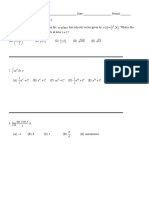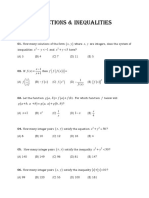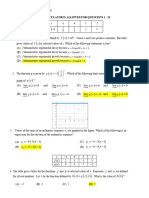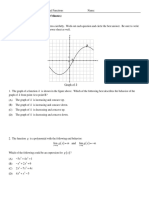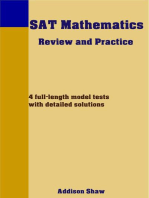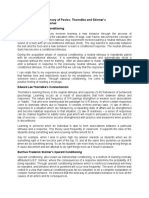Ap Questions Chapter 2.1-2.4
Ap Questions Chapter 2.1-2.4
Uploaded by
quangdungta10Copyright:
Available Formats
Ap Questions Chapter 2.1-2.4
Ap Questions Chapter 2.1-2.4
Uploaded by
quangdungta10Original Title
Copyright
Available Formats
Share this document
Did you find this document useful?
Is this content inappropriate?
Copyright:
Available Formats
Ap Questions Chapter 2.1-2.4
Ap Questions Chapter 2.1-2.4
Uploaded by
quangdungta10Copyright:
Available Formats
Practice AP Questions 2.1-2.
4 Name:___________________________________
1) If f(x) = , then f’(0) =
(A) -2 (B) 0 (C) 1 (D) (E)
2) A particle moves along the x-axis in such a way that its position at time t is given by . What is the
acceleration of the particle at time t=0?
(A) -4
(B) -2
(C) -3/5
(D) 2
(E) 4
3) Let f be the function given by f(x) = tanx and let g be the function given by g(x) = x 2. At what value of x in the interval
0 ≤ x ≤ π do the graphs of f and g have parallel tangent lines?
(A) 0
(B) 0.660
(C) 2.083
(D) 2.194
(E) 2.207
4) Two functions f(x) and g(x) are differentiable. If h(x) = x2g(x) – f(3x + 1), determine the value of h’(x).
(A) 2xg’(x) – 3f’(3x + 1)
(B) 2xg’(x) – f’(3)
(C) x2g’(x) + 2xg(x) – f’(3x + 1)
(D) x2g’(x) + 2xg(x) – 3f’(3x + 1)
(E) x2g’(x) – f’(3x + 1)
5) Let f and g be differentiable functions such that
If h(x) = f(g(x)), then h’(1) =
(A)
-9 (B) 15 (C) 0 (D) -5 (E) -12
6) If f(x) = (2 + 3x)4, then the fourth derivative of f is
(A) 0 (B) 4!(3) (C) 4!(34) (D) 4!(35) (E) 4!(2 + 3x)
7) The at x = 3 is
(A) -1 (B) 0 (C) 1 (D) 3 (E) nonexistent
8) If y = 7 is a horizontal asymptote of a rational function f, then which of the following must be true?
(A) (B) (C) (D) (E)
9) Let f(x) be a continuous and differentiable function. The table below gives the values of f(x) and f’(x), the derivative of
f(x), at several values. If g(x) = , what is the value of g’(2)?
(A) -1/8
(B) 0 x 1 2 3 4
f(x) -3 -8 -9 0
(C) 1/16 f’(x) -5 -4 3 16
(D) 1/64
(E) 16
10) If f(x) = cos2(x), then f ’’ (π) =
(A) -2 (B) 0 (C) 1 (D) 2 (E) 2π
11) Two particles leave the origin at the same time and move along the y-axis with their respective positions determined
by the functions y1 = cos2t and y2 = 4sint for 0 < x < 6. For how many values of t do the particles have the same
acceleration?
(A) 0 (B) 1 (C) 2 (D) 3 (E) 4
12) Evaluate .
(A) 5/2 (B) 5/16 (C) 40 (D) 160 (E) The limit DNE
13) If f is continuous on [2, 6], with f(2) = 20 and f(6) = 10, then the Intermediate Value Theorem says which of the
following is true?
I. f(x) = 25 does not have a solution on [2, 6]
II. f(x) = 17 has a solution on [2, 6]
III. f(x) = 0 has a solution on [2, 6]
(A) I only (B) II only (C) III only (D) I and II only (E) I, II, and III
You might also like
- SBC 23 o 30029 Decision TrialDocument128 pagesSBC 23 o 30029 Decision TrialThe Western JournalNo ratings yet
- Analysis and Forecasting of Crude ModelsDocument13 pagesAnalysis and Forecasting of Crude ModelsMartín E. Rodríguez AmiamaNo ratings yet
- Practice For The GRE Math Subject TestDocument31 pagesPractice For The GRE Math Subject TestCharles RamboNo ratings yet
- Daniel B. Domingues Da Silva - The Atlantic Slave Trade From West Central Africa, 1780-1867-Cambridge University Press (2018)Document243 pagesDaniel B. Domingues Da Silva - The Atlantic Slave Trade From West Central Africa, 1780-1867-Cambridge University Press (2018)soaresmsousa827100% (3)
- Structural Steel LessonsDocument7 pagesStructural Steel LessonsIngeniero EstructuralNo ratings yet
- An Earth Schooling KG SAMPLEDocument35 pagesAn Earth Schooling KG SAMPLEearthschooling100% (1)
- AP Calc Exam2Document25 pagesAP Calc Exam2Jordan Miles100% (1)
- Midterm Review 3 ANSWERSDocument4 pagesMidterm Review 3 ANSWERSar02No ratings yet
- 1998 AP Calculus AB ExamDocument39 pages1998 AP Calculus AB Examthemadhatter106No ratings yet
- SAT 2 Math2010-2 PDFDocument7 pagesSAT 2 Math2010-2 PDFJinhui ZhengNo ratings yet
- DifferentiationDocument27 pagesDifferentiationNur ARSLANNo ratings yet
- JEE Main Test - 08 (Paper - 01) _ Answer Key & Solution Explanation _ 15-Dec-2024Document38 pagesJEE Main Test - 08 (Paper - 01) _ Answer Key & Solution Explanation _ 15-Dec-2024dixitlakshya895No ratings yet
- Questions 2005Document6 pagesQuestions 2005gtan@icacademy.orgNo ratings yet
- 2020 AP Calculus Practice Exam by Patrick Cox-1-38-1-34Document34 pages2020 AP Calculus Practice Exam by Patrick Cox-1-38-1-34Ashok KambhamNo ratings yet
- 2022 Final - Exam - 1212 Q v3 Final RevDocument8 pages2022 Final - Exam - 1212 Q v3 Final RevValentín AcuñaNo ratings yet
- Math GRE Exercises: Charlie MarshakDocument48 pagesMath GRE Exercises: Charlie MarshakHan JuliaNo ratings yet
- Test14 Summer School-1Document3 pagesTest14 Summer School-1ChrisNo ratings yet
- 10 Application of Derivative DPDocument17 pages10 Application of Derivative DPtikam chandNo ratings yet
- SAT 2 Past Paper - Mathematics Level 2 Year 2014Document6 pagesSAT 2 Past Paper - Mathematics Level 2 Year 2014Jinhui ZhengNo ratings yet
- Practice For The GRE Math Subject Test!: Charles RamboDocument23 pagesPractice For The GRE Math Subject Test!: Charles RamboGoutam DeyNo ratings yet
- Week 2Document11 pagesWeek 2JaZz SFNo ratings yet
- 11 CAPS 11 Student Copy AnanthGarg&On Trak0EduCompetishunDocument4 pages11 CAPS 11 Student Copy AnanthGarg&On Trak0EduCompetishunganeshshanbhag14No ratings yet
- Calc BC Introductory Derivatives Exam (Unit 2)Document5 pagesCalc BC Introductory Derivatives Exam (Unit 2)Dillon BriesemeisterNo ratings yet
- Workbook 1Document3 pagesWorkbook 1loredpwoNo ratings yet
- CPP - Mean Value TheoremDocument3 pagesCPP - Mean Value Theoremavika.rakhi76No ratings yet
- BC NO Calculator MCDocument20 pagesBC NO Calculator MCbingfang wuNo ratings yet
- Sat Math Function QuizDocument3 pagesSat Math Function QuizVarakorn NarairatNo ratings yet
- AP Calculus BC Released Exam 2008 Multiple-Choice Questions (College Board)Document26 pagesAP Calculus BC Released Exam 2008 Multiple-Choice Questions (College Board)vingts100% (1)
- revision qp collectionDocument24 pagesrevision qp collectionmahendra schoolNo ratings yet
- Functions & InequalitiesDocument15 pagesFunctions & InequalitiesYash PatelNo ratings yet
- SAT 2 Past Paper - Mathematics Level 2 Year 2013Document7 pagesSAT 2 Past Paper - Mathematics Level 2 Year 2013Jinhui ZhengNo ratings yet
- SAT 2 Past Paper - Mathematics Level 2 Year 2011Document7 pagesSAT 2 Past Paper - Mathematics Level 2 Year 2011Jinhui ZhengNo ratings yet
- Worksheet III, IV Math 1011Document2 pagesWorksheet III, IV Math 1011gebriegashaw9No ratings yet
- MHF4U - Final Review P1 PDFDocument5 pagesMHF4U - Final Review P1 PDFBảo TrânNo ratings yet
- $maths Class Xii Sample Paper Test 12 For Board Exam 2024Document5 pages$maths Class Xii Sample Paper Test 12 For Board Exam 2024Prerna JainNo ratings yet
- Math 11WORKSHEET 1Document3 pagesMath 11WORKSHEET 1nebiyutafesse543No ratings yet
- Examen Final Cursillo 2021Document8 pagesExamen Final Cursillo 2021Valentín AcuñaNo ratings yet
- XII - MIDTERM I RETEST (2024- 2025)Document3 pagesXII - MIDTERM I RETEST (2024- 2025)Nethraa VathiNo ratings yet
- Prairie Math League HS R187Document1 pagePrairie Math League HS R187peerlessben2024No ratings yet
- Functions DPP: SSB Guide Defence AcademyDocument19 pagesFunctions DPP: SSB Guide Defence Academyrishabhrrr229No ratings yet
- Worksheet - 7 Application of DerivativeDocument34 pagesWorksheet - 7 Application of DerivativeChetanNo ratings yet
- math 12th preboardDocument6 pagesmath 12th preboardnikitha.smathewsNo ratings yet
- LCD Test QuesDocument4 pagesLCD Test Quesrahulkumar88rahiNo ratings yet
- APPCU08 WKSTF AnswersDocument7 pagesAPPCU08 WKSTF Answerspausean20708No ratings yet
- A B E D E E C D E B C E: Ft./sec. $ 6.50Document5 pagesA B E D E E C D E B C E: Ft./sec. $ 6.50jelenicasabancicaNo ratings yet
- Chapter 1Document4 pagesChapter 1lilyq zNo ratings yet
- Test APPC Unit 1 MCQsDocument9 pagesTest APPC Unit 1 MCQsWhoamiNo ratings yet
- Alabama: Division I Comprehensive ExamDocument7 pagesAlabama: Division I Comprehensive ExamAlfredo EsquivelNo ratings yet
- Practice Test 5 Questions: 310 Part Iii / Eight Practice TestsDocument11 pagesPractice Test 5 Questions: 310 Part Iii / Eight Practice TestsKai Chung TamNo ratings yet
- Maths Mock Test - 5Document8 pagesMaths Mock Test - 5ModeetNo ratings yet
- Day 1 MCQDocument2 pagesDay 1 MCQbossofvip07No ratings yet
- 01 Question MathsDocument6 pages01 Question MathshamilearnNo ratings yet
- 12 Maths Model Exam - 3 - 2024Document9 pages12 Maths Model Exam - 3 - 2024aniesbegumNo ratings yet
- Mathematic Question Paper Set ADocument4 pagesMathematic Question Paper Set AADITHYA SUJINo ratings yet
- AP Practice ExamDocument18 pagesAP Practice ExamDSaulBNo ratings yet
- Analytic Geometry: Graphic Solutions Using Matlab LanguageFrom EverandAnalytic Geometry: Graphic Solutions Using Matlab LanguageNo ratings yet
- Transformation of Axes (Geometry) Mathematics Question BankFrom EverandTransformation of Axes (Geometry) Mathematics Question BankRating: 3 out of 5 stars3/5 (1)
- Functional Operators, Volume 2: The Geometry of Orthogonal SpacesFrom EverandFunctional Operators, Volume 2: The Geometry of Orthogonal SpacesNo ratings yet
- EarthWear Annual Report 2021Document16 pagesEarthWear Annual Report 2021renad.dajemNo ratings yet
- The 1954 Einsteins Handwritten Letter To Gutkind Regarding Religion - Translation in EnglishDocument1 pageThe 1954 Einsteins Handwritten Letter To Gutkind Regarding Religion - Translation in EnglishAnthony DernellisNo ratings yet
- Lab - Unit 5 - It Act 2000Document15 pagesLab - Unit 5 - It Act 2000Disha MohantyNo ratings yet
- Elzbieta Siepak ZMBM 2001 Sanctuary of The Divine Mercy in CracowDocument15 pagesElzbieta Siepak ZMBM 2001 Sanctuary of The Divine Mercy in Cracowisabel correaNo ratings yet
- BRGYDocument2 pagesBRGYbarangay paligawanNo ratings yet
- Course Outline - Drainage EngineeringDocument3 pagesCourse Outline - Drainage EngineeringKhairy OmerNo ratings yet
- Vandalur ZooDocument1 pageVandalur ZooKavi Mukilan100% (1)
- CH 02Document13 pagesCH 02leisurelarry999No ratings yet
- Spanish Civil War ICQ + ResponseDocument3 pagesSpanish Civil War ICQ + ResponseRicky ShiNo ratings yet
- Detailed Project ReportDocument117 pagesDetailed Project ReportShrikant BudholiaNo ratings yet
- Painting and Literature V. Woolf's To The Lighthouse" & Tracy Chevalier's Girl With A Pearl Earring"Document6 pagesPainting and Literature V. Woolf's To The Lighthouse" & Tracy Chevalier's Girl With A Pearl Earring"GeorgiAna NarcisaNo ratings yet
- Sample 3Document6 pagesSample 3Jhon Jhon OrtegaNo ratings yet
- Realism 2. Surrealism 3. Abstract 4. Dadaism 5. Impressionism 6. Pointillism 7. Fantasy 8. Pop ArtDocument8 pagesRealism 2. Surrealism 3. Abstract 4. Dadaism 5. Impressionism 6. Pointillism 7. Fantasy 8. Pop ArtTerence GadilNo ratings yet
- Summary of Pavlov, Thorndike and Skinner's TheoriesDocument2 pagesSummary of Pavlov, Thorndike and Skinner's TheoriesSittie Zainab ManingcaraNo ratings yet
- Written Report On SkyscrapersDocument41 pagesWritten Report On SkyscrapersDon LapusNo ratings yet
- Dental Cements PDFDocument77 pagesDental Cements PDFPrince Ahmed75% (4)
- Political Science Notes 2Document3 pagesPolitical Science Notes 2aaNo ratings yet
- GPR 312: Alternative Dispute Resolution Law G34/135786/2019 Question OneDocument10 pagesGPR 312: Alternative Dispute Resolution Law G34/135786/2019 Question Oneericosim ricoNo ratings yet
- Aller de LavantDocument14 pagesAller de LavantMark John AnthonyNo ratings yet
- Arjun Emf CVDocument2 pagesArjun Emf CVArjun PrasadNo ratings yet
- Adjective or Adverb Kl.6Document4 pagesAdjective or Adverb Kl.6Klaus MeyerNo ratings yet
- The Natzari Yeshua Vs KairiteDocument20 pagesThe Natzari Yeshua Vs KairiteNeve NincsNo ratings yet
- Topic-1A (Food and Health) (Autosaved) - 1-20Document20 pagesTopic-1A (Food and Health) (Autosaved) - 1-20lisaNo ratings yet
- Navatara Chakra: March 1, 2013Document1 pageNavatara Chakra: March 1, 2013indians jonesNo ratings yet
- How A Bill Really Becomes A Law Updated 2 19Document1 pageHow A Bill Really Becomes A Law Updated 2 19Levi MolenhourNo ratings yet






